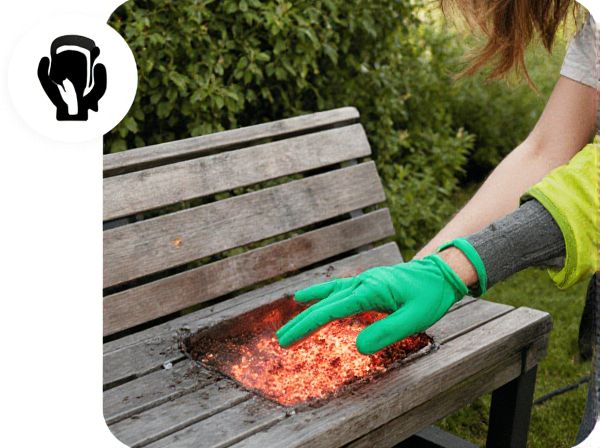
Heated benches vs heated floors Illustration
Heated benches in greenhouses provide targeted warmth directly to plants, promoting root development and reducing energy consumption by limiting heat to specific growing areas. Heated floors offer uniform temperature distribution across the entire greenhouse, enhancing overall climate control and preventing cold spots that can stress plants. Choosing between heated benches and floors depends on the crop type, energy efficiency goals, and the desired level of temperature precision within the greenhouse environment.
Table of Comparison
| Feature | Heated Benches | Heated Floors |
|---|---|---|
| Heat Distribution | Direct heat to plants via elevated surfaces | Even heat across entire greenhouse floor |
| Energy Efficiency | Lower energy consumption for targeted heating | Higher energy use due to larger area coverage |
| Installation Cost | Moderate; simpler installation | Higher; requires floor modifications |
| Maintenance | Easy access, simpler maintenance | Complex, may require floor repairs |
| Plant Suitability | Ideal for small pots and seed trays | Best for large-scale planting and root zone warming |
| Temperature Control | Localized control at bench level | Whole greenhouse temperature regulation |
| Durability | Moderate; affected by bench wear | High; embedded systems protected |
Introduction to Greenhouse Heating Solutions
Heated benches provide targeted warmth directly to plant roots, enhancing growth efficiency while conserving energy compared to broader heating methods. Heated floors distribute consistent heat throughout the greenhouse environment, promoting uniform temperature control and reducing cold spots. Selecting the appropriate heating system depends on crop type, energy costs, and desired growth outcomes.
How Heated Benches Work
Heated benches in greenhouses operate by circulating warm water or electric heating elements beneath the bench surface, directly warming plant roots for accelerated growth. This method ensures precise temperature control at the root zone, enhancing seed germination and plant development. Unlike heated floors, heated benches allow for more targeted heat distribution, reducing overall energy consumption and providing flexibility in bench placement.
How Heated Floors Work
Heated floors in greenhouses operate by circulating warm water or electric heating elements beneath the soil or growing surfaces, raising the root zone temperature to promote plant growth and mitigate cold stress. This system ensures uniform heat distribution, improving energy efficiency compared to localized heated benches. Consistent warmth from heated floors supports robust root development, enhances nutrient uptake, and extends the growing season in cooler climates.
Energy Efficiency Comparison
Heated floors in greenhouses provide more energy-efficient heat distribution by radiating warmth evenly across the entire growing area, reducing heat loss compared to heated benches that concentrate warmth in localized spots. The thermal mass of heated floors retains heat longer, leading to lower energy consumption and consistent soil temperature for optimal plant growth. Heated benches, while easier to install and control per plant group, typically require more energy to maintain targeted temperatures due to less efficient heat dispersion.
Installation Requirements and Costs
Heated benches in greenhouses require custom fabrication and electrical connections, often resulting in moderate installation costs compared to heated floors, which involve comprehensive underfloor wiring or hydronic piping with higher initial investment. Heated floors demand significant groundwork and professional installation to ensure effective heat distribution, raising both labor and material expenses. Choosing between heated benches and floors depends on budget constraints and the specific heating efficiency needed for plant cultivation.
Impact on Plant Growth and Health
Heated benches provide localized warmth directly to plant roots, promoting faster germination and improved nutrient uptake, which enhances overall plant growth and vigor. Heated floors distribute heat evenly across the greenhouse, stabilizing ambient temperature and reducing stress on plants by maintaining consistent soil warmth. Both systems boost root development and disease resistance, but heated floors offer a more uniform environment that benefits larger plant populations.
Temperature Control and Uniformity
Heated floors provide consistent, evenly distributed warmth throughout the greenhouse, ensuring uniform temperature control at the root zone which promotes healthier plant growth. Heated benches offer targeted heating primarily to plant containers, allowing precise temperature regulation but often resulting in less uniform heat distribution across the entire growing area. Optimal greenhouse temperature control depends on balancing these methods to maintain consistent root-zone warmth while preventing localized hot spots.
Maintenance and Longevity
Heated floors in greenhouses typically require less maintenance than heated benches due to their embedded installation and durable materials, reducing the risk of damage from daily use. Heated benches may need more frequent repairs or replacements of heating elements and surface materials because they are exposed and subject to physical stress. Over time, heated floors generally offer greater longevity, providing consistent heat distribution with minimal upkeep, making them a cost-effective solution for long-term greenhouse heating.
Suitability for Different Greenhouse Crops
Heated benches provide targeted warmth ideal for seedlings, young plants, and sensitive crops such as lettuce and herbs, promoting rapid root development. Heated floors distribute consistent heat across the entire greenhouse, benefiting larger plants like tomatoes, peppers, and cucumbers by maintaining optimal soil temperature. Choosing between heated benches and heated floors depends on crop type, growth stage, and specific temperature requirements for maximizing yield and plant health.
Choosing the Right System for Your Greenhouse
Heated benches provide targeted warmth directly to plants, making them ideal for seed starting and delicate crops, while heated floors offer uniform heat distribution beneficial for overall greenhouse climate control. Selecting the right heating system depends on factors such as the types of plants grown, greenhouse size, and energy efficiency goals. Integrating sensors and thermostats ensures optimal temperature regulation regardless of the chosen heating method.
Heated benches vs heated floors Infographic

 gardendif.com
gardendif.com